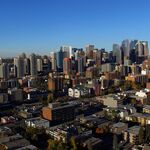CBBarnett
Senior Member
"My Beltline is growing faster than my beltline!"
Seriously though...
A few short years ago, I would have described Calgary's main problem as lacking visible infrastructure for retail, arts, nightlife, and active lifestyle in the inner city. Yes, there were all of those things if you knew where to look, and the suburbs were fine (according to expectations of what suburbs ought to offer) but the inner city was a tough sell to people considering alternatives like Vancouver and Montreal. These stats about the Beltline's growth confirm that the inner city continues to improve and attract investment. Parking lots give way to offices and condos; auto thoroughfares give way to multimodal streets with separated bike lanes, parklets, street art, and attractive lighting. It's been 100 years since the Beltline has felt so safe, livable, and optimistic.
That said, there are some major concerns. Namely, the vast majority of Calgary's growth continues to be suburban. That in itself is not necessarily a problem, but undoubtedly it will contribute to (a) a dramatic regional increase in kilometers-driven-by-private-vehicles and (b) an increasing urban/suburban political divide.
My prognosis is that the market forces that create sprawl are nearly intractable, especially in the prairies where supply is so high. We can limit subsidies, but ultimately it may be human nature to choose a house with many rooms on a large and quiet property to tasteful and modest harmony with one's community (at least at a certain stage in life). I believe the prescription for this ailment is not to ignore and write off our wasting appendages, but rather to draw the suburbs into the fold with a minimum guaranteed level of (unsubsidized) transit and active infrastructure to encourage inclusion and participation in our utopian project. Apologies for the hyperbole, but it is what it is. We want every man, woman, and child to feel that the inner city is theirs.
And so, my point is that we should temper our celebration of Beltline growth with attention to the reality that this success pales in comparison to our continued tendency to sprawl.
Agree completely. The Beltline's continued success should be viewed in context of the overall machine - a relatively minor drop in a suburban bucket. Taking the inner city communities of the traditional urban core (Sunnyside, DT (Centre, West End), EV, Beltline, Bankview, Sunalta, Mission, Inglewood, Bridgeland, LMR, Cliff Bung) Calgary's urban core is up ~7,000 in the last 5 years to around 70,000 people. That is great, but nothing compared to the 200,000 we added overall, largely to the fringes.
This is one way that size will help us. Every competitor city in Canada has a far stronger "sprawl-wall" pressures: Toronto, Montreal and Vancouver are so large they push more into a more urban existence because suburban life on the edge becomes increasingly impractical. Commute times and congestion start biting into quality of life and put pressure on housing expectations once a city gets large enough that roads and low-density sprawl can no longer support the lifestyle then often espouse (one of freedom). Calgary has only begun to have that conversation, buoyed for a long time thanks to ultra-high incomes and high suburban subsidies that kept the suburban dream alive longer here than elsewhere.
With that said, the green-shoots are everywhere as this process has begun. Townhomes and infills cover wide swaths of the inner city outside the core and small apartments are springing up farther afield - from Killarney to Dalhousie to Albert Park. New inner communities are designed as urban ones - East Village, but also Currie and University District - are being designed at unheard of densities from opening day. Still drops in a bucket, but what is an ocean but a multitude of drops?




